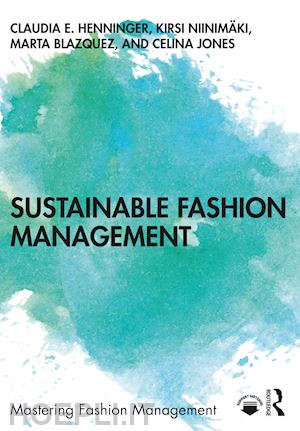
-
DISPONIBILITÀ IMMEDIATA
{{/disponibilitaBox}}
-
{{speseGratisLibroBox}}
{{/noEbook}}
{{^noEbook}}
-
Libro
-
Sustainable Fashion Management
henninger claudia e.; niinimäki kirsi; blazquez marta; jones celina
58,98 €
56,03 €
{{{disponibilita}}}
NOTE EDITORE
This book provides a holistic and accessible approach to sustainable fashion management. It offers an interdisciplinary and practical outlook, combining theory with practical application from a management perspective and underpinned by the Sustainable Development Goals throughout. The book helps students to gain a better understanding of what sustainable fashion is and how it is implemented across the fashion industry, through business model innovations, innovative designs, new technology and digital approaches, and material innovations. Global case studies are employed throughout each chapter, including fashion companies and events of all sizes, alongside other pedagogical features to aid learning, including key learning points, chapter objectives, and textboxes explaining key terminology. This is an essential textbook for those investigating sustainable fashion, whether from a design or management perspective, providing the knowledge and tools for a future career. It is designed to serve Fashion Business and Management, Fashion Marketing, Fashion Buying and Merchandising and Fashion Technology courses, at all levels, and will also be valuable reading for those already working within the fashion industry and studying for professional qualifications. Online resources include chapter-by-chapter PowerPoint slides and a test bank.SOMMARIO
Foreword Part 1 – Management of Sustainable Fashion Chapter 1 Emergence Of Sustainability And Its Management In The Fashion Industry Management – art and science Sustainability – definitions and meaning Sustainability in fashion and sustainable fashion Importance of sustainable fashion in the 21st century Chapter 2 Sustainable Fashion – Company Perspective Sustainability as a strategy Issues in the fashion industry surrounding sustainable fashion Case study - Understanding sustainability and value – the example of We Are Knitters Chapter 3 Sustainable Fashion – consumer view Sustainable fashion and consumer perceptions New developments in sustainable fashion Chapter 4 Circular economy Evolution of the circular economy Case study: Thinking outside the box – the example of Freitag Business model innovations The circular economy – zero waste fashion Zero Waste Fashion – Pre-consumer Approaches Zero Waste Fashion – Post-consumer Approaches Opportunities and barriers to the circular economy Case Study: Circularity in the Fashion Industry – The example of Hetty Rose Part 2 Managing sustainable fashion through design Foreword Chapter 1 2.1 New system understanding for design 2.1.1 Redesigning industrial design processes Chapter 2 2.2. Design for a circular economy 2.2.1. Intentional design for recycling 2.2.2 Design for alternative business models Chapter 3 Slowing down the fashion system through design Slow fashion and garment lifetimes Designing value for secondhand fashion Chapter 4 Designing carbon-neutral fashion Responsibility, safety, and risk management Transparency and code of conduct Clean chemistry and ethical fashion Control, trust, and crisis management Chapter 5 Fashion design in a new paradigm Part 3: Sustainability, Fashion, and Technology Foreword Chapter 1 3.1.1 The current scenario for fashion retail: from multichannel to omnichannel 3.1.1.1 The role of technology in omnichannel retailing 3.1.1.2 Consumer’ intake about the use of technology 3.1.1.3 Digital channels 3.1.2 The use of technology to promote sustainable behaviours 3.1.3 The importance of sustainability communication Chapter 2 3.2 Digital Sustainability 3.2.1 Introduction 3.2.2 The impact of online shopping: returns 3.2.3 The nature of online shopping: the importance of touch and vision 3.2.4 The role of specific technologies 3.2.4.1 Image Interactive Technology 3.2.5. Sustainability communication and digital channels 3.2.5.1. The importance of narrative strategies in social media communication 3.2.6. Key developments and industry practices Chapter 3 3.3 Digital Fashion 3.3.1. What is digital fashion? 3.3.1.1 Digital Fashion 3.3.1.2 Non fungible tokens (NFTs) 3.3.1.3 Digital Fashion Marketplaces 3.3.1.4 The Metaverse 3.3.1.5 Digital Fashion Shows 3.3.2 Will digital fashion become mainstream? The importance of communication 3.3.3. Key developments and industry practices 3.3.4 Case Studies Part 4: Material Innovations in Sustainable Fashion Foreword Chapter 1 4.1 Fibre Selection 4.1.1. 20th Century Production 4.1.2 Natural Fibres 4.1.2.1 Plant Fibres 4.1.2.2 Animal Fibres 4.1.2.3 Man-made (Manufactured) Fibres 4.1.3. 21st Century Developments 4.1.4. Case Study Task - Alternative fibres for textile production - Bananatex® Chapter 2 4.2 Fabric Creation 4.2.1 Preparation of Raw Materials 4.2.2 Woven Fabrics 4.2.3 Knitted Fabrics 4.2.4 Nonwoven Fabrics 4.2.4.1 Leather 4.2.4.2. Case Study Task – The knitted jumper that used to be a pair of woven jeans – Innovations in Fabric Construction by We Are Knitters Chapter 3 4.3 Fabric Finishes and Surface Design 4.3.1 Fabric Colouration – Overview 4.3.2 Fabric Preparation 4.3.3 Application of Colourants 4.3.4 Innovative Approach to Colouration 4.3.5 Case Study – Sustaina-jeans Innovation CapsuleAUTORE
Claudia E.Henninger is Senior Lecturer in Fashion Marketing Management at the University of Manchester, UK. Kirsi Niinimäki is Associate Professor in Design at Aalto University, Finland. Marta Blazquezis SeniorLecturer in Fashion Marketing at the University of Manchester, UK. Celina Jones is Lecturer in Fashion Technology at the University of Manchester, UK.ALTRE INFORMAZIONI
- Condizione: Nuovo
- ISBN: 9780367564551
- Collana: Mastering Fashion Management
- Dimensioni: 9.75 x 6.75 in Ø 1.15 lb
- Formato: Brossura
- Illustration Notes: 34 color images, 19 color tables, 20 color halftones and 14 color line drawings
- Pagine Arabe: 242
- Pagine Romane: xiv
